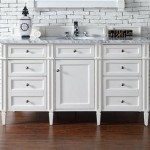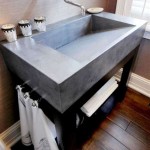Stone Bathroom Vanity Units: A Comprehensive Guide
Stone bathroom vanity units are a popular choice for homeowners seeking to elevate the aesthetic appeal and functionality of their bathrooms. Renowned for their inherent beauty, durability, and timeless elegance, stone vanities offer a luxurious touch that can transform a mundane space into a spa-like retreat. This article provides a comprehensive overview of stone bathroom vanity units, covering their various types, benefits, considerations when selecting one, and maintenance advice.
Types of Stone Used in Bathroom Vanity Units
The term "stone" encompasses a wide range of materials, each possessing unique characteristics in terms of appearance, durability, and cost. Several types of stone are commonly used in the construction of bathroom vanity units, each offering distinct advantages.
Granite: Granite is an igneous rock known for its robustness and resistance to heat, scratches, and stains. Its granular appearance, which varies depending on the mineral composition, provides a natural and sophisticated look. Granite is a generally good choice for high-traffic bathrooms due to its durability. The porous nature of granite requires sealing to prevent staining from spills and water damage.
Marble: Marble is a metamorphic rock prized for its elegant veining and smooth, polished surface. Its luxurious appearance makes it a popular choice for upscale bathrooms. Marble is softer and more porous than granite, making it more susceptible to scratches and stains. Regular sealing and gentle cleaning are essential to maintain its beauty. Acids found in common household cleaners can etch marble surfaces, so pH-neutral cleaners are necessary.
Quartz: Quartz is an engineered stone composed of crushed quartz crystals bound together with resin. This manufacturing process results in a non-porous, highly durable, and stain-resistant surface. Quartz vanities are available in a wide range of colors and patterns, offering versatility in design. Unlike natural stone, quartz doesn’t require sealing owing to its non-porous nature. Quartz is an excellent option for those seeking a low-maintenance and aesthetically pleasing vanity.
Limestone: Limestone is a sedimentary rock characterized by its neutral color and earthy texture. Its natural appearance lends a warm and inviting feel to bathroom spaces. Limestone is more porous than granite or marble, requiring more frequent sealing to protect it from stains and water damage. It is also susceptible to scratching and etching, so gentle cleaning practices are necessary.
Slate: Slate is a metamorphic rock known for its distinctive layered appearance and natural cleft texture. Its dark, muted colors and rugged aesthetic make it a suitable choice for contemporary and rustic bathroom designs. Slate is naturally water-resistant and relatively durable, but it can be susceptible to chipping and staining. Regular sealing can help to enhance its water resistance and protect it from stains.
Travertine: Travertine is a type of limestone formed around mineral spring deposits. It is characterized by its pitted surface and earth-toned colors. Its natural texture adds character to bathroom vanities. Travertine is porous, requiring sealing to prevent water damage and staining. The pits and voids in the surface also need to be properly filled during installation to prevent water accumulation.
Benefits of Stone Bathroom Vanity Units
Selecting a stone bathroom vanity unit offers a multitude of benefits beyond its aesthetic appeal. These advantages contribute to both the functionality and long-term value of the bathroom.
Durability and Longevity: Stone, particularly granite and quartz, is exceptionally durable and resistant to wear and tear. A stone vanity unit can withstand the rigors of daily use, maintaining its appearance for many years. This durability translates to a long lifespan, making it a worthwhile investment for homeowners.
Enhanced Aesthetic Appeal: The natural beauty of stone adds a touch of luxury and sophistication to any bathroom. The unique veining and patterns found in natural stone like marble and granite create a focal point that elevates the overall design. The availability of different stone types and colors allows homeowners to choose a vanity that complements their existing décor.
Increased Home Value: Installing a stone bathroom vanity unit can increase the perceived value of a home. Prospective buyers are often drawn to the high-end look and feel of stone, making it a desirable feature. Upgrading to stone can be a smart investment, particularly if the bathroom is undergoing a larger renovation.
Water Resistance: While some stones are more porous than others, most stone vanity units can be treated with sealants to enhance their water resistance. This is crucial in a bathroom environment where water exposure is frequent. Proper sealing helps to prevent water damage, staining, and the growth of mold and mildew.
Heat Resistance: Stone surfaces, especially granite and quartz, are resistant to heat. This is a valuable feature in a bathroom where styling tools like curling irons and hair straighteners are frequently used. The heat resistance of stone helps to prevent damage to the vanity surface.
Considerations When Selecting a Stone Bathroom Vanity Unit
Choosing the right stone bathroom vanity unit requires careful consideration of several factors, including budget, style preferences, maintenance requirements, and the size and layout of the bathroom. A well-informed decision will ensure that the selected vanity unit meets both aesthetic and functional needs.
Stone Type and Properties: Understanding the properties of different stone types is crucial. Consider the porosity, durability, stain resistance, and maintenance requirements of each option. For high-traffic bathrooms where spills are common, a non-porous and stain-resistant stone like quartz may be the best choice. For those seeking a luxurious look and are willing to commit to regular maintenance, marble could be more suitable.
Size and Layout: Measure the available space in the bathroom to determine the appropriate size for the vanity unit. Consider the placement of plumbing fixtures and the overall layout of the room. A vanity that is too large may overwhelm the space, while one that is too small may not provide adequate storage.
Style and Design: Choose a stone vanity unit that complements the overall style and design of the bathroom. Stone is available in a variety of colors, patterns, and finishes, allowing homeowners to create a cohesive and visually appealing space. Consider the style of the cabinets and hardware to ensure that they coordinate with the stone top.
Budget: Stone vanity units can range in price depending on the type of stone, size, and complexity of the design. Establish a budget beforehand to narrow down the options. Keep in mind that the cost of installation and sealing should also be factored into the budget.
Sink and Faucet Compatibility: Ensure that the chosen stone vanity unit is compatible with the desired sink and faucet. Consider the size and shape of the sink, as well as the placement of the faucet holes. Some stone vanities come pre-drilled with faucet holes, while others require custom drilling.
Installation: Proper installation is essential to ensure the longevity and stability of a stone vanity unit. It is generally recommended to hire a professional installer who has experience working with stone. Improper installation can lead to cracks, leaks, and other problems.
Maintenance and Care of Stone Bathroom Vanity Units
Proper maintenance and care are essential to preserving the beauty and longevity of a stone bathroom vanity unit. Different types of stone require different cleaning and maintenance practices. Understanding these requirements is key to keeping the vanity looking its best.
Regular Cleaning: Wipe down the stone surface regularly with a soft cloth and a pH-neutral cleaner. Avoid using abrasive cleaners, scouring pads, or harsh chemicals, as these can damage the surface. For marble and limestone, it is particularly important to use cleaners specifically designed for these materials to avoid etching.
Sealing: Most natural stone vanity tops, including granite, marble, limestone, and travertine, require regular sealing to protect them from stains and water damage. The frequency of sealing depends on the porosity of the stone and the level of use. A good rule of thumb is to seal the vanity at least once a year, or more frequently if necessary. Consult with a professional for recommendations on the appropriate sealant for the specific type of stone.
Spill Prevention: Clean up spills immediately to prevent staining, especially on porous stones like marble and limestone. Use coasters under drinks and avoid placing potentially staining substances directly on the vanity surface. Common culprits include wine, coffee, juice, and acidic cleaners.
Stain Removal: If a stain does occur, try to remove it as quickly as possible. There are various stain removal products available specifically designed for stone surfaces. Follow the manufacturer's instructions carefully. For stubborn stains, a professional stone cleaner may be necessary.
Scratch Prevention: Protect the stone surface from scratches by using cutting boards when preparing food and avoiding the use of sharp objects directly on the vanity. Place mats or trivets under hot styling tools like curling irons and hair straighteners.
Professional Maintenance: Consider hiring a professional stone restoration company for periodic deep cleaning and maintenance. These professionals can polish and reseal the stone, restoring its original luster and protecting it from damage.
By carefully selecting the appropriate stone type, installing the vanity unit correctly, and implementing a regular maintenance routine, homeowners can enjoy the beauty and durability of a stone bathroom vanity unit for many years. The investment in a stone vanity is an investment in the long-term value and aesthetic appeal of the bathroom.

Stone Vanity Units Bathroom Vanities Paramount

Bathroom Design Furniture Stone Vanity Vai

Stone Bathroom Vanity Unit Sink Cabinet In Grey With Shelf

Bathroom Design Furniture Stone Vanity Vai

Oak And Stone Vanity Unit 110 Cm Bathroom Washbasin Tikamoon

Crosswater Limit 600mm Stone Vanity Worktop Sanctuary Bathrooms
.jpg?strip=all)
ᐈ Aquatica Millennium Blck 150 Stone And Wood Bathroom Vanity Buy Best S

Novello Vanity Unit Stone Basin 1200mm Aquaroc

Isla 600mm Wall Hung Vanity Unit Marble Sintered Stone Countertop Drench

Oxford Stone Vanity Unit With Solid Oak Top Aspenn Furniture
Related Posts







